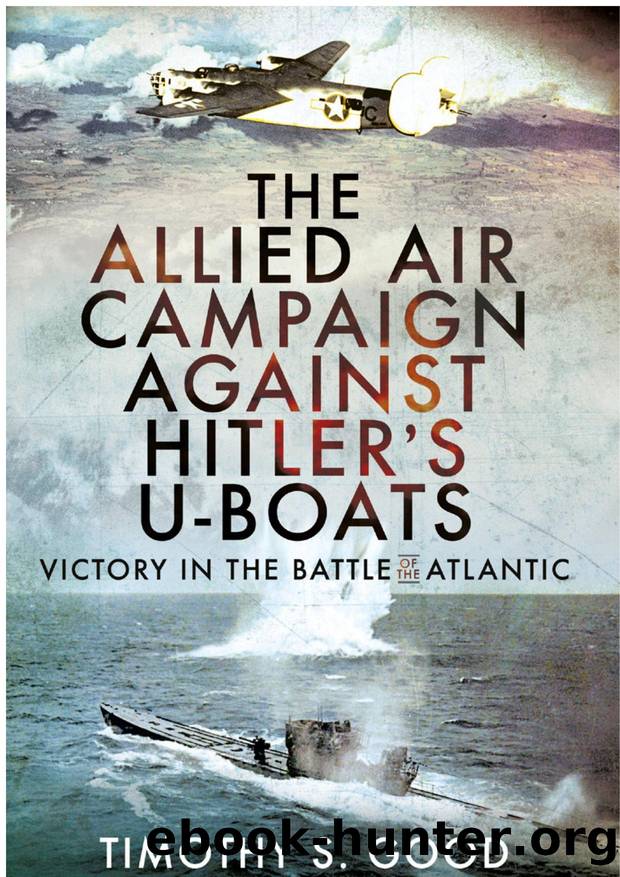The Allied Air Campaign Against Hitler's U-Boats: Victory in the Battle of the Atlantic by Timothy S Good

Author:Timothy S Good [Good, Timothy S]
Language: eng
Format: epub
Tags: History, Wars & Conflicts, World War II, General, Military, Aviation & Space, Modern, 20th Century, Transportation, Ships & Shipbuilding, Submarines
ISBN: 9781399096522
Google: jsSAEAAAQBAJ
Amazon: B0B98QSMVL
Publisher: Frontline Books
Published: 2022-09-14T18:30:00+00:00
Chapter 13
NovemberâDecember 1943
During the last two months of 1943 the Allied air campaign continued to succeed, with the Liberators taking the leading role. The B-24s attacked six of the twelve U-boats destroyed by aircraft during this time. Allied forces totalled twenty U-boats destroyed at sea, resulting in aircraft contributing 60 per cent of the total, and Liberatorsâ successes accounting for 30 per cent, nearly one-in-three of all Allied U-boat victories. However, the greatest insight regarding anti-submarine efforts during these months occurred not at sea, but on shore, with the Allied conferences that differed sharply from that in Casablanca in 1942. The Alliesâ altered attitude towards Dönitzâs U-boats, as witnessed at the Sextant and the Eureka conferences, stemmed from the successful U-boat assaults, especially by Allied aircraft. The conferences well demonstrated that 1943 marked the turning point in the U-boat war. The hope with which Dönitz had greeted the new year with his new position and vastly increased influence had been dissipated by Allied aircraft during the long months that followed his promotion.
British Liberators successfully attacked two Nazi Type VIIC U-boats during this time. On 16 November, 86 Squadron Liberator Mk. III âMâ rendezvoused with its assigned convoy in the mid-North Atlantic at 0906 hours, and at 1025 hours the crew spotted U-280 west of Ireland. The pilot, Flight Officer J.H. Bookless, initiated an âimmediate attackâ. On approach, the nose gunner opened fire and scored hits on the conning tower as the U-boat remained on the surface and instituted âtight turns to portâ. German gun fire disabled the outer port engine and the depth charges âovershot, so the aircraft prepared for a second attackâ. Bookless swung the Liberator around and âthree minutes laterâ the nose gunner struck the conning tower multiple times while âknocking out the forward gunnerâ. Yet, the depth charges overshot, with the ânearest exploding 30ft from the hullâ. Bookless remained in the area and âa few minutes later the U-boat slowly submerged without any forward movementâ. The aircraft loitered for over an hour and while the crew witnessed âno evidence of damageâ, the attacks did sink U-280. The forty-nine crew members went down with the boat, which was on its first patrol having not engaged any Allied vessels.¹
The following month, on the 13th, in the Bay of Biscay, 53 Squadron Liberator Mk. V âBâ began a âSquare searchâ hunt in the darkness at 0413 hours after the Allies suspected that a U-boat was operating in the area. The RAF had equipped Mk. V B-24s with radar, but this morning, the aircraft suffered both radar and intercom issues, resulting in only momentary contacts. This irregularity required the crew to use the Leigh Light for verification, an action that immediately brought the aircraft to the attention of U-391âs crew and they responded with machine gun fire. The crew âswitched offâ the light and the pilot, Squadron Leader G. Crawford, âmanoeuvred to attack up moonâ. The U-boat fire ceased, leading the crew to assume that the Germans had âlost sight of the aircraftâ.
Download
This site does not store any files on its server. We only index and link to content provided by other sites. Please contact the content providers to delete copyright contents if any and email us, we'll remove relevant links or contents immediately.
The Radium Girls by Kate Moore(11921)
100 Deadly Skills by Clint Emerson(4840)
Rise and Kill First by Ronen Bergman(4701)
The Templars by Dan Jones(4627)
The Doomsday Machine by Daniel Ellsberg(4415)
The Rape of Nanking by Iris Chang(4136)
Killing England by Bill O'Reilly(3951)
Hitler in Los Angeles by Steven J. Ross(3900)
Stalin by Stephen Kotkin(3875)
12 Strong by Doug Stanton(3508)
Hitler's Monsters by Eric Kurlander(3268)
Blood and Sand by Alex Von Tunzelmann(3138)
The Code Book by Simon Singh(3073)
Darkest Hour by Anthony McCarten(3070)
The Art of War Visualized by Jessica Hagy(2943)
Hitler's Flying Saucers: A Guide to German Flying Discs of the Second World War by Stevens Henry(2714)
Babylon's Ark by Lawrence Anthony(2620)
The Second World Wars by Victor Davis Hanson(2480)
Tobruk by Peter Fitzsimons(2442)
